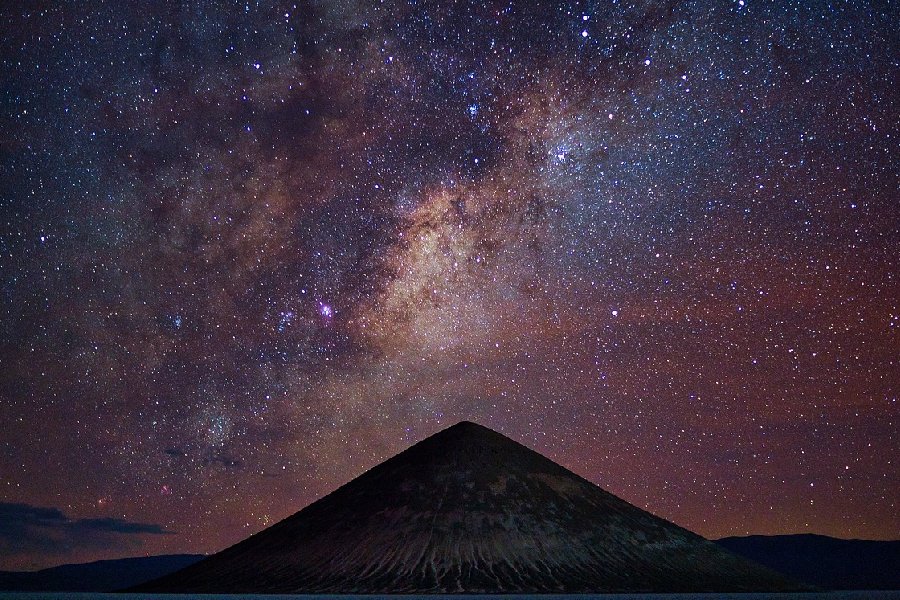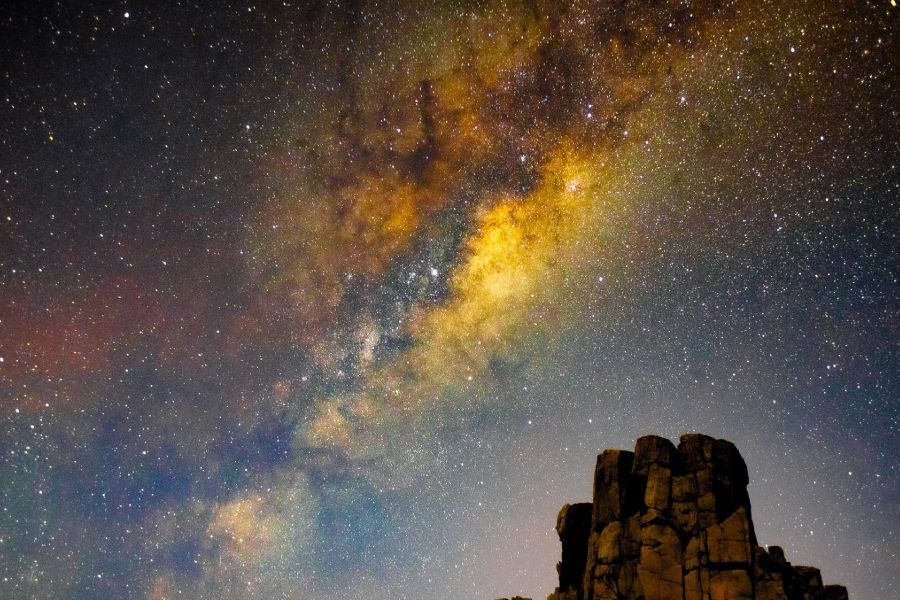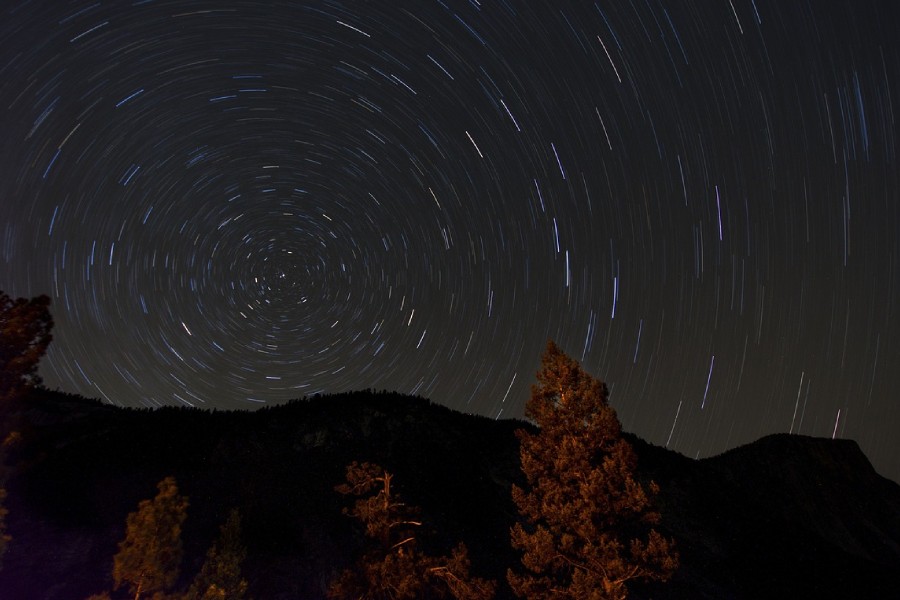Gazing at the glory of a starry night sky can make people wonder—how do photographers capture such images of celestial objects like nebulae, galaxies, and planets? What does it take to move astrophotography from simplistic snapshots to transporting works of art? Don’t worry; we have some astrophotography tips to share!
Continue reading our comprehensive guide for astrophotography, covering essential equipment capabilities tailored for low-light capture. From there, delve into practical post-production techniques and creative tricks that transform your celestial snapshots into vibrant masterpieces, breathing life into majestic cosmic scenery.
Let’s begin!

Astrophotography Tips
Fundamental aspects
Achieving excellent astrophotography involves mastering manual camera settings, focusing techniques, and managing light pollution. The foundation is built on having the right gear and understanding the necessary techniques. However, applying these skills during actual photo sessions is the real challenge.
Even with advanced tools, their effectiveness is limited without proper handling. This emphasizes the importance of being well-prepared with resources and executing techniques accurately.
For beginners, this combination propels them beyond capturing average snapshots. Taking control of exposure variables and ensuring sharpness transforms their work from a mere task into intentional artistry.
Manual focus
Manual focus becomes crucial in astro-imaging because autofocus features struggle with dark and intricate celestial fields filled with scattered light sources. Achieving ultra-precise focus is key to revealing the detailed structures of star clusters, the faint atmospheric gases in nebulae, and subtle surface features on celestial bodies like Mars.
Live view, especially with zoom magnification, significantly aids manual focus in astrophotography. The process involves framing a bright reference star and confirming sharpness at 100% crop, ensuring optimal focal distance.
To enhance accuracy, specialized Bahtinov masks are placed over telescope openings, creating calibration patterns that help precisely focus cameras. Astrophotographers can capture resolved cosmic attractions by leveraging these advanced technologies and methods.
Shutter speed
Shutter speed is crucial in astrophotography as it determines the total light captured. This is especially important when capturing fast-moving events in the night sky, such as meteor showers, auroras, lunar transits, etc. Choosing faster shutter speeds is key to freezing motion and obtaining clear images of these fleeting phenomena.
On the other hand, slower shutter speeds are beneficial for capturing extremely faint signals from distant galaxies and subtle nebula gases during longer exposures. It’s important to note that recommended settings vary significantly depending on the specific celestial target.
Using automatic modes can be a helpful learning tool for those just starting in astrophotography. However, mastering manual shutter durations becomes essential for still imaging and tracking mount movements as one progresses.
This transition allows photographers to unlock artistic flexibility. By adjusting settings manually, they can strike a balance between managing noise, capturing intricate details, and creatively incorporating motion blur based on their intentions when portraying cosmic subjects. Moving from automatic to manual modes transforms simple documentation into compelling astrophotography visions.
Astrophotography Tips and Tricks for Trails
Embarking on the captivating journey of astrophotography, capturing the allure of star trails requires a combination of technical know-how and creative finesse. Here, we delve into valuable tips and tricks that will elevate your star trail photography, helping you craft stunning images that showcase the dynamic beauty of the night sky.
From equipment choices to mastering long exposure techniques, let’s discover some of the best astrophotography tips for beginners.
Choosing the right equipment
Selecting the appropriate equipment is paramount when aiming to capture captivating star trails in astrophotography. Opting for a fast wide-angle lens is a wise choice, as it enables the photographer to capture a broader portion of the night sky and enhances the visibility of star trails and celestial objects in the images.
In addition to the lens choice, the photographer should consider using focus shifts to add an extra layer of interest to the compositions. Converging perspective lines can be created within the frame by adjusting the focus during a long exposure. This technique not only adds a dynamic element to the images but also emphasizes the depth and dimension of the celestial scene.
When selecting equipment, it is crucial to ensure the stability of the setup. A sturdy tripod is essential for astrophotography, especially when capturing long exposures for star trails. This minimizes camera shake, ensuring sharp and clear images. Additionally, having a remote shutter release or a timer function can reduce the risk of introducing vibrations to the camera during the exposure.
Optimal camera positioning
For optimal camera positioning in astrophotography, facing the camera either north or south is recommended, as opposed to east or west. This choice allows star trails to rotate around the North Star, resulting in mesmerizing time lapses in your photographs.
This positioning creates a captivating effect as the stars seemingly revolve around a central point. It adds a dynamic and visually engaging element to the composition.
During the post-production phase, photographers are encouraged to experiment with creative colors and blurred textures further to enhance the sense of motion in their images. Adjusting color tones and introducing subtle textures can elevate the overall aesthetic of the astrophotography, making the star trails more vibrant and captivating.
Mastering long-exposure techniques
Achieving captivating star patterns with long exposure techniques requires patience. Use tracking mounts, remote timers, and battery packs to do this effectively. These tools help automate capturing continuous exposures lasting 30 minutes or more.
Additionally, consider foreground elements, such as mountains, to enhance contrast and provide a geographical reference point. Don’t avoid embracing a bit of lens distortion and motion blurring to add a dynamic touch to your photos.

Addressing light pollution
Understanding the impact of light pollution
Light pollution notably impacts the number and clarity of stars in astrophotography. When artificial light is scattered, especially by air moisture and dust, it forms a widespread glow in the sky.
This glow obscures the visibility of faint celestial bodies close to the light sources and changes the overall colors and contrast in the surroundings. In essence, light pollution diminishes the quantity of stars visible and affects their quality in astrophotography.
Choosing optimal shooting locations
Individuals should consider visiting designated Dark-sky preserves away from large cities to reduce light pollution whenever feasible. Referring to light pollution models for guidance in this endeavor is advisable. Additionally, fast and sensitive cameras with wider apertures can enhance the ability to capture more details before interference becomes noticeable.
Effective filtering and shielding strategies
Employ filters to screen out sodium and mercury wavelengths to refine the observations. Individuals can focus on specific wavelengths of interest by experimenting with narrowband emissions targeting. To ensure precision, shields block any stray light emanating from peripheral sources.
After capturing the data, enhancing contrast during post-processing becomes crucial. This step helps highlight standalone subjects against darker backgrounds, allowing for clearer and more detailed analysis.
Types of Cameras for Astrophotography
DSLR vs mirrorless cameras
DSLRs utilize mirrors and optical viewfinders, offering precise previews of what the sensor will capture. With their specialized sensors and lenses, they excel in providing low noise and sharp images, ideal for astrophotography. However, they tend to be bulkier and more reliant on mechanical components.
On the other hand, mirrorless systems occupy less space and boast a wider range of lens compatibility. Despite this advantage, they rely on electronic viewfinders, which can drain the battery faster.
Advances in mirrorless technologies
Mirrorless technology has evolved significantly, posing a formidable challenge to the performance of higher-end DSLRs in the night sky and Milky Way imaging. This is especially true for recent mirrorless cameras with enhanced thermal control and long exposure features.
In astrophotography, both DSLRs and mirrorless systems boast excellent capabilities. DSLRs, however, stand out for their robust support and seamless compatibility with astronomy accessories, such as telescope mounts and tethering tools.
Despite this, mirrorless options have their own set of advantages. They are notably more lightweight and portable, serving as all-in-one standalone kits that prove ideal for packing on remote dark sky adventures. When choosing sensors within each category, opting for higher ISOs and effective noise reduction is key to achieving the best results.
Full-frame vs crop sensor cameras
Higher-end full-frame sensors offer significant advantages for astrophotography. First, their larger surface area allows them to collect more total light, resolving finer details and enhancing color differentiation when imaging faint celestial objects. Also, full-frame sensors perform better in low-light, high ISO conditions, effectively minimizing noise.
However, it’s worth noting that quality cropped sensor cameras have their benefits. They typically cost less and can utilize a wider array of telephoto lenses optimized for their imaging area. Moreover, advancements in noise filtering software have narrowed the gap between full-frame and cropped sensors.
Choosing the ideal camera depends on various factors such as budget, skill level, and astrophotography goals. While full-frame models may require pricier lenses to exploit their capabilities fully, they excel in capturing rich nebula gases and galaxies. On the other hand, cropped sensors still deliver admirable performance, allowing photographers to save money for accessories and capture sweeping nightscapes.
To make an informed decision, you must compare your shooting goals with each camera type’s strengths and available lens systems. Consider new processing techniques that effectively enlarge cropped camera resolution to nearly match full-frame output.

Mastering Advanced Astrophotography
Fundamentals for success
Mastering the basics sets the stage for success in astrophotography. One must become adept at navigating camera settings in manual mode with confidence. It is crucial to study compositions and practice balancing exposures to accurately capture the brightness of stars.
Moreover, establishing a workflow for processing and archiving images is equally important. This systematic approach not only streamlines the learning process but also facilitates growth in astrophotography. By following these fundamental steps, a solid foundation is laid for achieving success in capturing the beauty of the night sky.
Equipment and accessories
Quality gear investments
Embracing a commitment to top-notch equipment, use quality cameras, lenses, and tracking mounts. These tools boast wide apertures, high ISO sensitivities, and precise movement to enhance the practice of long-exposure photography.
Users can seamlessly integrate third-party additions such as intervalometers, guiding telescopes, and focusing tools to optimize setups. This ensures a comprehensive and effective approach to capturing stunning images with precision and creativity.
Power management logistics
In preparing for each session, one must meticulously assess gear requirements. This involves ensuring that camera batteries are fully charged, mobile power banks are ready, and backup drives are accessible. The goal is to avoid disruptions during a shoot caused by avoidable power or storage shortages, especially when capturing elusive celestial alignments.
Image processing and editing
Align and integrate image sets
Sophisticated astrophotography involves merging several long exposure shots. To ensure accurate alignment of different elements, photographers use calibration frames. This helps prevent any distortions in the final combined image. They make use of stacking software, which is capable of integrating multiple shots seamlessly.
Scheduling photo shoots during peak galactic visibility periods is essential, even if the weather appears unfavorable. Photographers can unveil stunning details hidden within seemingly ordinary frames by layering and processing the images afterward.
Enhance details in post
Processing unveils subtle details in nebula gases and enhances distinctions that may go unnoticed in standalone photos. To achieve this, one can selectively sharpen specific star clusters and galaxies using mask layers.
Additionally, employing innovative AI methods from tools like Starry Landscape Stacker and DeepSkyStacker helps amplify faint signals while minimizing unwanted noise.
Even for those new to post-processing, implementing fundamental adjustments such as white balancing, contrast curves, vibrance saturation, and slight dehazing can significantly enhance the quality of lackluster shots.
Creativity and composition
Compelling framing
Photographers should angle their cameras to include captivating foreground elements such as trees, rocks, or architecture against starry skies to enhance the flow and capture stunning images. They can achieve a balanced composition by positioning celestial bodies at the intersection points within the rule of thirds grid overlays.
In order to find unique foreground elements, photographers should explore locations off the typical tourist routes with minimal light pollution. They can create visually striking images by aligning these earthly features with celestial focal points.
Lighting and color
To enhance the allure of the night sky, photographers experiment with various techniques. One method involves strategically placing off-camera speedlights and LED panels to illuminate scenery and props while maintaining a balanced exposure against the backdrop of starry skies.
By adjusting the white balance and calibrating colors, subtle nebular hues can be brought out, adding depth to the images. Enhancing RAW images using custom galaxy LUTs in astrophotography presets can further accentuate the cosmic beauty.
Another creative approach involves employing light painting techniques. This involves delicately brushing over the scenery with colored gels to add artistic accents that complement the vibrancy of the night sky.
Conclusion
By now, one should recognize that astrophotography extends beyond merely capturing a fleeting glimpse of the cosmos—it embodies an art form that intricately weaves together inspiration, technical expertise, and aesthetic vision. Throughout the entire process, from the initial click of the camera to the ultimate showcase, each step requires deliberate effort to cultivate an intuition for translating the enigmatic wonders of space into profound human insights.
Continuing to gaze upward from Earth, armed with the newfound capabilities unearthed through these astrophotography tips, one’s unique lens onto the infinite cosmos is poised to awaken profound revelations. These revelations materialize within oneself and the observers as constellations gracefully dance across the night sky.
